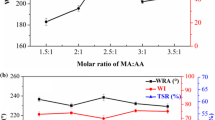Abstract
Low molecular weight copolymers of maleic anhydride and vinyl acetate were prepared to develop formaldehyde free cross-linking agents. Since lower molecular weight is favorable for efficient penetration of the finishing agent into the cotton fibers in the padding process, the concentration of the initiator, chain transfer agent and the monomer ratios were varied to obtain copolymers of low molecular weights. The prepared polymers were characterized by GPC,1H-NMR, FTIR, DSC and TGA. Copolymers of molecular weights of 2 000 to 10 000 were obtained and it was found that the most efficient method of controlling the molecular weight was by varying the monomer ratios. Poly(maleic anhydride-co-vinyl acetate) did not dissolve in water, but the maleic anhydride residue hydrolyzed within a few minutes to form poly(maleic acid-co-vinyl acetate) and dissolved in water. However, the maleic acid units undergo dehydration to form anhydride groups on heating above 160 °C to some extent even in the absence of catalysts. The possibility of using the copolymers as durable press finishing agent for cotton fabric was investigated. Lower molecular weight poly(maleic anhydride-co-vinyl acetate) copolymers were more efficient in introducing crease resistance, which appears to be due to the more efficient penetration of the crosslinking agent into cotton fabrics. The wrinkle recovery angles of cotton fabrics treated with poly(maleic anhydride-co-vinyl acetate) copolymers were slightly lower than those treated with DMDHEU and were higher when higher curing temperatures or higher concentrations of copolymer were used, and when catalyst, NaH2PO2, was added. The strength retention of the poly(maleic anhydride-co-vinyl acetate) treated cotton fabrics was excellent.
Similar content being viewed by others
References
C. Q. Yang and X. Wang,J. Appl. Polym. Sci.,34, 1573 (1996).
C. Q. Yang, L. Xu, S. Li, and Y. Jiang,Textile Res. J.,68, 457 (1998).
C. Q. Yang and X. Wang,J. Polym. Sci., Polym. Chem.,35, 557 (1997).
C. Q. Yang and X. Wang,J. Appl. Polym. Sci.,75, 327 (2000).
Z. Mao and C. Q. Yang,J. Appl. Polym. Sci.,79, 319 (2001).
Z. Mao and C. Q. Yang,J. Appl. Polym. Sci.,81, 2142 (2001).
C. M. Welch,Textile Chemist and Colorist,29, 21 (1997).
C. M. Welch and G. Peters,Textile Chemist and Colorist,29, 22 (1997).
G. Odian, “Principles of Polymerization”, 3rd ed., p.479, John Wiley & Sons, New York, 1991.
J. J. Maurer, D. J. Eustace, and C. T. Ratcliffe,Macromolecules,20, 196 (1987).
A. Eisenberg, T. Yokoyama, and E. Sambalido,J. Polym. Sci.,7, 1717 (1969).
Author information
Authors and Affiliations
Corresponding author
Rights and permissions
About this article
Cite this article
Yoon, K.J., Woo, J.H. & Seo, Y.S. Formaldehyde free cross-linking agents based on maleic anhydride copolymers. Fibers Polym 4, 182–187 (2003). https://doi.org/10.1007/BF02908276
Received:
Revised:
Accepted:
Issue Date:
DOI: https://doi.org/10.1007/BF02908276




